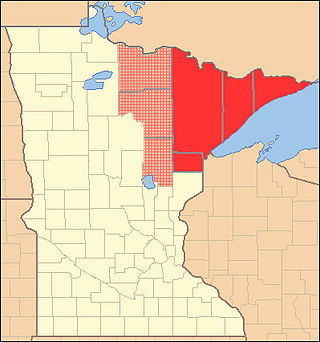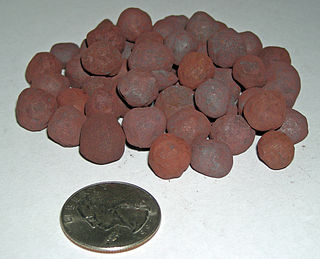
Lake County is a county in the U.S. state of Minnesota. As of the 2020 census, the population was 10,905. Its county seat is Two Harbors.

Virginia is a city in St. Louis County, Minnesota, United States, on the Mesabi Iron Range. With an economy heavily reliant on large-scale iron ore mining, Virginia is considered the Mesabi Range's commercial center. The population was 8,423 at the 2020 census. Virginia is a part of the Duluth metropolitan area and U.S. Highway 53 runs through town.

The Mesabi Iron Range is a mining district in northeastern Minnesota following an elongate trend containing large deposits of iron ore. It is the largest of four major iron ranges in the region collectively known as the Iron Range of Minnesota. First described in 1866, it is the chief iron ore mining district in the United States. The district is located largely in Itasca and Saint Louis counties. It has been extensively worked since 1892, and has seen a transition from high-grade direct shipping ores through gravity concentrates to the current industry exclusively producing iron ore (taconite) pellets. Production has been dominantly controlled by vertically integrated steelmakers since 1901, and therefore is dictated largely by US ironmaking capacity and demand.

The Iron Range is collectively or individually a number of elongated iron-ore mining districts around Lake Superior in the United States and Canada. Much of the ore-bearing region lies alongside the range of granite hills formed by the Giants Range batholith. These cherty iron ore deposits are Precambrian in the Vermilion Range and middle Precambrian in the Mesabi and Cuyuna ranges, all in Minnesota. The Gogebic Range in Wisconsin and the Marquette Iron Range and Menominee Range in Michigan have similar characteristics and are of similar age. Natural ores and concentrates were produced from 1848 until the mid-1950s, when taconites and jaspers were concentrated and pelletized, and started to become the major source of iron production.

The Duluth, Missabe and Iron Range Railway (DM&IR), informally known as the Missabe Road, was a railroad operating in northern Minnesota and Wisconsin that used to haul iron ore and later taconite to the Great Lakes ports of Duluth and Two Harbors, Minnesota. Control of the railway was acquired on May 10, 2004, by the Canadian National Railway (CN) when it purchased the assets of Great Lakes Transportation.

The Arrowhead Region is located in the northeastern part of the U.S. state of Minnesota, so called because of its pointed shape. The predominantly rural region encompasses 10,635.26 square miles (27,545.2 km2) of land area and includes Carlton, Cook, Lake and Saint Louis counties. Its population at the 2000 census was 248,425 residents. The region is loosely defined, and Aitkin, Itasca, and Koochiching counties are sometimes considered as part of the region, increasing the land area to 18,221.97 square miles (47,194.7 km2) and the population to 322,073 residents. Primary industries in the region include tourism and iron mining.

The Vermilion Range exists between Tower, Minnesota and Ely, Minnesota, and contains significant deposits of iron ore. Together with the Mesabi and Cuyuna Ranges, these three constitute the Iron Ranges of northern Minnesota. While the Mesabi Range had iron ore close enough to the surface to enable pit mining, mines had to be dug deep underground to reach the ore of the Vermilion and Cuyuna ranges. The Soudan mine was nearly 1/2 mile underground and required blasting of Precambrian sedimentary bedrock.

Hill-Annex Mine State Park is a state park of Minnesota, United States, interpreting the open-pit mining heritage of the Mesabi Range. The park is located north of the city of Calumet, in Itasca County, Minnesota. The park provides access to fossil material exposed by mining from the Cretaceous era Coleraine Formation.

The Lake Vermilion-Soudan Underground Mine State Park is a Minnesota state park at the site of the Soudan Underground Mine, on the south shore of Lake Vermilion, in the Vermilion Range (Minnesota). The mine is known as Minnesota's oldest, deepest, and richest iron mine, and now hosts the Soudan Underground Laboratory. As the Soudan Iron Mine, it has been designated a U.S. National Historic Landmark.

The Hull–Rust–Mahoning Open Pit Iron Mine in Hibbing, Minnesota, United States, is the largest operating open-pit iron mine in Minnesota. The pit stretches more than three miles (5 km) long, two miles (3 km) wide, and 535 feet (163 m) deep. It was established in 1895 and was one of the world's first mechanized open-pit mines.
The Seven Iron Men, also known as Merritt Brothers, were iron-ore pioneers in the Mesabi Range in northeastern Minnesota and the creation of the city that is now known as Mountain Iron. In the late 1800s, the Merritt family founded the largest iron mine in the world and initiated the consolidation of the American railway system into what would ultimately become the United States Steel Corporation. Their story was told, in part, by the book Seven Iron Men by Paul de Kruif. The book was first published in 1929.

The U.S. Army Corps of Engineers Duluth Vessel Yard is a federal port facility in Duluth, Minnesota, United States. It houses the United States Army Corps of Engineers (USACE) resources used to maintain the harbors of the Twin Ports of Duluth and Superior, Wisconsin. It was established on Minnesota Point in 1903, though most of its present configuration dates to a flurry of construction in 1941.

Edna G is a tugboat which worked the Great Lakes and is now preserved as a museum ship. Edna G was built by the Cleveland Shipbuilding Company in 1896 for the Duluth and Iron Range Railroad at a cost $35,397.50. She was named for the daughter of J. L. Greatsinger, president of the railroad.

Manganese is a ghost town and former mining community in the U.S. state of Minnesota that was inhabited between 1912 and 1960. It was built in Crow Wing County on the Cuyuna Iron Range in sections 23 and 28 of Wolford Township, about 2 miles (3 km) north of Trommald, Minnesota. After its formal dissolution, Manganese was absorbed by Wolford Township; the former town site is located between Coles Lake and Flynn Lake. First appearing in the U.S. Census of 1920 with an already dwindling population of 183, the village was abandoned by 1960.

William James Olcott was an American football player and mining and railroad executive in the Mesabi Range. He played college football for the University of Michigan from 1881 to 1883 and was captain of the 1882 and 1883 teams. After receiving his degree, he worked in the iron ore mining industry for more than 40 years. He was president of the Oliver Iron Mining Company from 1909 to 1928 and president of the Duluth, Missabe and Iron Range Railway from 1901 to 1909.
The Oliver Iron Mining Company was a mining company operating in Minnesota, United States. It was one of the most prominent companies in the early decades of mining on the Mesabi Range. As a division of U.S. Steel, Oliver dwarfed its competitors—in 1920, it operated 128 mines across the region, while its largest competitor operated only 65.

Elcor is a ghost town, or more properly, an extinct town, in the U.S. state of Minnesota that was inhabited between 1897 and 1956. It was built on the Mesabi Iron Range near the city of Gilbert in St. Louis County. Elcor was its own unincorporated community before it was abandoned and was never a neighborhood proper of the city of Gilbert. Not rating a figure in the national census, the people of Elcor were only generally considered to be citizens of Gilbert. The area where Elcor was located was annexed by Gilbert when its existing city boundaries were expanded after 1969.

Iron mining in the United States produced 48 million metric tons of iron ore in 2019. Iron ore was the third-highest-value metal mined in the United States, after gold and copper. Iron ore was mined from nine active mines and three reclamation operations in Michigan, Minnesota, and Utah. Most of the iron ore was mined in northern Minnesota's Mesabi Range. Net exports were 3.9 million tons. US iron ore made up 2.5 percent of the total mined worldwide in 2015. Employment as of 2014 was 5,750 in iron mines and iron ore treatment plants.
The Duluth, Missabe and Northern Railway (DM&N) was a railroad company in the U.S. state of Minnesota. It was one of the earliest iron ore hauling railroads of the area, said to have built the largest iron ore docks in the world, and later was one of the constituent railroads in the merger that formed the Duluth, Missabe and Iron Range Railway.

Hulett Clinton Merritt was an American real estate developer, investor, rancher and art collector. He sold real estate in his hometown of Duluth, Minnesota, developed Texas City, Texas, with other businessmen, and invested in real estate in Los Angeles, California, where he built the Merritt Building. He was a director and large shareholder of U.S. Steel. As a majority shareholder of the United Electric and Power Company, he installed electricity and gas in 17 cities in California, including Santa Barbara and San Diego. He owned a large ranch in Tulare County.



















